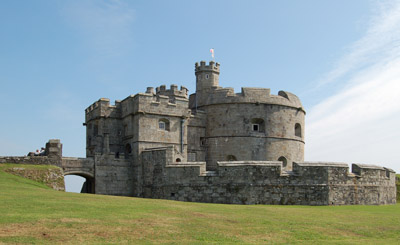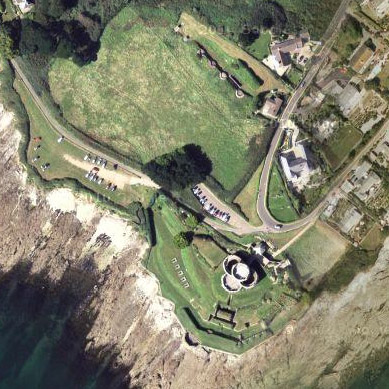 |
Pendennis Castle
Falmouth, Cornwall, UK
|
|
 |
England's King Henry VIII (1491-1547) needed a male heir. To continue the royal line of the Tudors, all he really needed was an heir, not necessarily a male one, but dude wanted a BOY! His wife, Catherine of Aragon (1485-1536), did her best to produce an actual, living boy for King Henry...but a total of six pregnancies resulted in only two actual living girls.
What's a king to do when he's not getting what he wants, and he feels absolutely no responsibility to act in a reasonable fashion? What Henry chose to do was ask the Pope for an annulment of his marriage to Catherine, to which Pope Clement VII (1478-1534) replied, and I quote, nuh-uh.
In short order, Henry had himself named head of the Anglican church, essentially cutting the Pope out of the British religion business, and removing any impediment the king might have from losing Catherine and marrying somebody with a more compliant womb.
|
 |
|
|
As King Henry VIII bashed his way into his second marriage (he ultimately would be married six times), it was not lost on the other crowned heads of Europe that his now ex-wife Catherine was of Spanish nobility, and that their marriage had been a rather important factor in keeping Spain and England at peace with each other. Spain and France cozied up to one another as a result, and when Henry took a moment to notice the fallout that his wienergames had caused, he found his island nation to be insufficiently fortified against the hostile navies that were surely soon to be on their way to English shores...The Pope asked France and Spain to invade England and restore the Catholic church's authority.
|
 Castle Pendennis the Device Fort Castle Pendennis the Device Fort |
 |
Henry began fortifying the southern coast of England in 1539 with the latest in fortification technology: The Device Fort. The 1539 Device Programme resulted in the construction of 30 castles and forts along the south of England, ranging in size from relatively simple earthen bulwarks to such concentrically lovely forts as Pendennis Castle, a squat, stoutly-engineered artillery bastion.
Other Device Forts in southern English counties of Kent, Hampshire and Cornwall look almost like wedding cakes: Platforms of attractive circles, each made to house artillery...just like a wedding cake. |
|
But I sense your brow furrowing at the non-starfortishness of a Device Fort. While it's certainly obvious to those of us who appreciate the pointiness of the starfort now, King Henry, himself an engineering enthusiast, thought Device Forts were swell. Pendennis Castle was built in 1539 to protect the mouth of the river Fal (gee, I wonder if that's where the name Falmouth came from?), along with Saint Mawes Castle (built from 1540 to 1543) on the other side of the river, from French and/or Spanish incursion.
|
In 1598, Queen Elizabeth I (1533-1603) had Pendennis Castle further fortified, and with the rumblings of civil war in the early 1640's, further fortification was undertaken. Finally, we're talking about a starfort!!
During the English Civil War (1642-1651), Pendennis Castle served as a refuge for King Charles II (1630-1685) before he sailed for France in 1646, ahead of the Pariamentarians who wanted his head. Pendennis Castle was the last major position in to be surrendered by Royalist forces to the Parliamentarians, after withstanding a five-month siege, in August of 1646. The 1500 men, woman and children in the castle weren't failed by Henry and Elizabeth's walls and ramparts, but by their own empty stomachs.
The castle of our interest remained relatively peaceful for the next few centuries, notwithstanding much frantic upgrading of its guns: Particularly by the end of the 19th
|
 |
 Saint Mawes Castle, on the east bank of the River Fal Saint Mawes Castle, on the east bank of the River Fal |
|
century, big gun technology was advancing at such a rapid pace, the engineers at Pendennis Castle were replacing guns every 20 minutes. Not really, but frequently.
|
|
Pendennis Castle appears to be a popular tourist attraction, based on the number of photos that are available online at such photo-sharing services as Flickr. Several examples of the many different guns that were mounted at the fort over the centuries are represented there today: Here are an 18-pounder cannon from the 17th century and a 6-pounder rapid fire gun from the 20th. |
During the Second World War (1939-1945), antisubmarine nets were stretched across the river from Pendennis Castle to Saint Mawes Castle, to keep German U-Boats out of the harbor and in the open sea where they could be shot at. 31 people in Falmouth were killed by German bombing during the war. Today, Pendennis Castle keeps up what looks to be an amazingly delightful regimen of reenactments, re-created historical elements and various ways to make you happy to part with your money. Wedding ceremonies are regularly held at the castle... I'd certainly love to get married at a starfort. To whom, I have no idea, but it would definitely be to someone who could provide me with lots of male heirs.
|
|
|
|
|
|
 |




